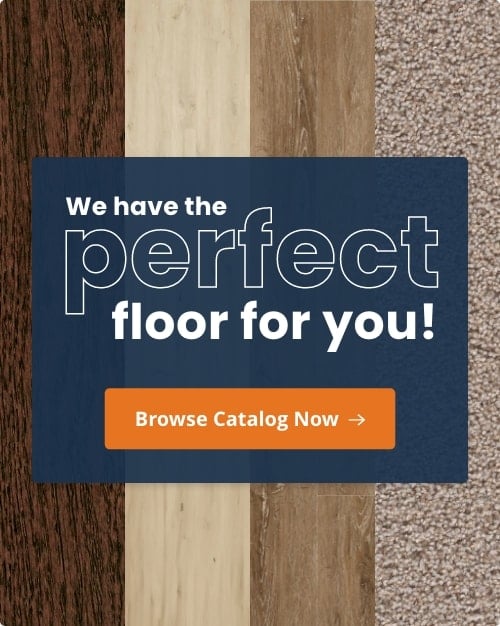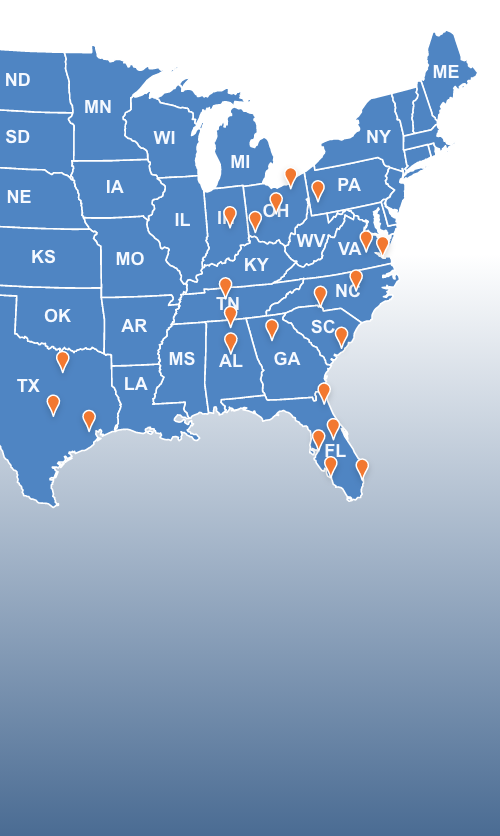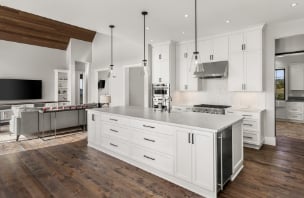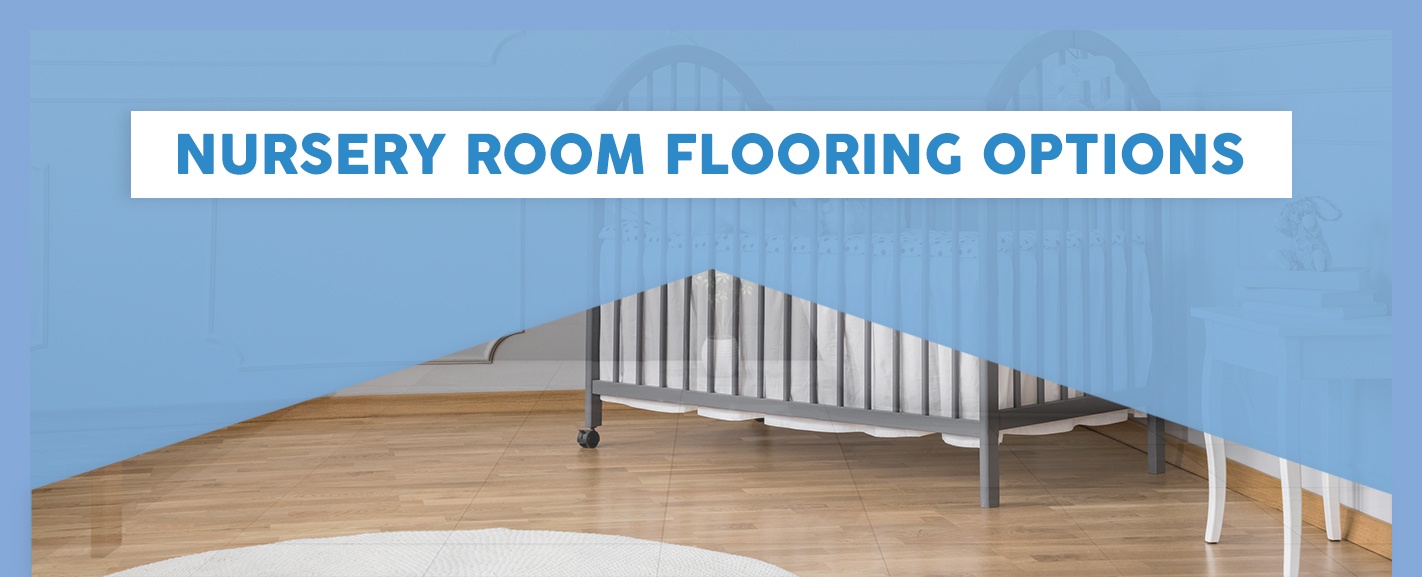

Table of Contents
- Best Types of Flooring for Nurseries
- What to Consider When Choosing Carpet for Your Baby’s Nursery
- Tips for Choosing the Best Nursery Room Flooring
- Find Nursery Flooring at 50 Floor
The arrival of a new baby is an exciting time. It’s also a time filled with preparations. You’ve taken birthing classes, spent hours debating names and chosen a pediatrician. But what about the nursery?
If you’re anticipating the pitter-patter of little feet, then you’re likely spending a lot of time figuring out where your little one will sleep when they make their grand entrance. Creating a comfortable space where you and your little one can relax during late-night feedings and after diaper changes is a rite of passage for first-time and seasoned parents alike.
It’s easy to focus on choosing a paint color and selecting a crib. But have you considered what kind of nursery flooring you need? Why is the flooring for babies such a big deal?
Sure, the floor in your nursery should be beautiful to look at, but it’s also important to choose baby room flooring that will hold up to the demands of a young child — that means it should also be durable and safe. It should help maintain warmth — both in temperature and aesthetics — and it should prevent extra noise from interrupting your little one’s sweet dreams.
Schedule a Free In-Home Consultation
Best Types of Flooring for Nurseries
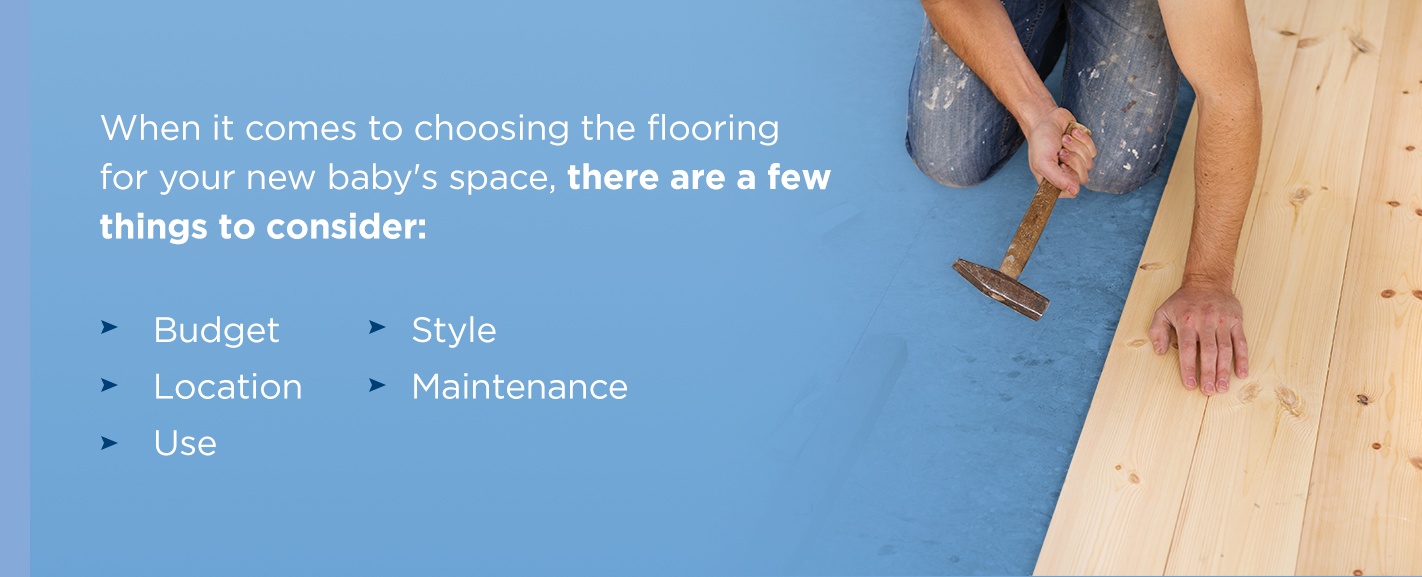

There are many different types of flooring on the market today, including hardwood, luxury vinyl, laminate and carpet. But are there specific kid-friendly flooring options? Which flooring is the safest flooring for babies?
Before you dive into the benefits of specific types of flooring, it’s a good idea to take a few minutes to figure out what you’re looking for. When it comes to choosing the flooring for your new baby’s space, there are a few things to consider:
- Budget: How much flooring will I need? How much can I afford to spend?
- Location: Is the baby’s room next to an older sibling’s room? Is it upstairs or downstairs? Does it tend to get cold in the winter?
- Use:Do I plan to spend most of my time in the nursery, or will it simply be a sleeping place? Do I expect the baby to continue to use this bedroom as they grow?
- Style: Will the décor be modern or traditional? Bright or pastel-colored? Wood or painted furniture?
- Maintenance: How much time do I have to devote to cleaning the floor?
There are no right or wrong answers to these questions. The point is to determine what you need your flooring to do and how much you can spend. Once you have the answers to those questions, you can easily sort through available flooring options to find the best option for you and your baby.
Take Our Quiz to Find Your Flooring Style
There are many different kinds of flooring on the market today, but when it comes to flooring for a baby’s nursery — or any child’s room for that matter — the top options to consider are:
1. Luxury Vinyl
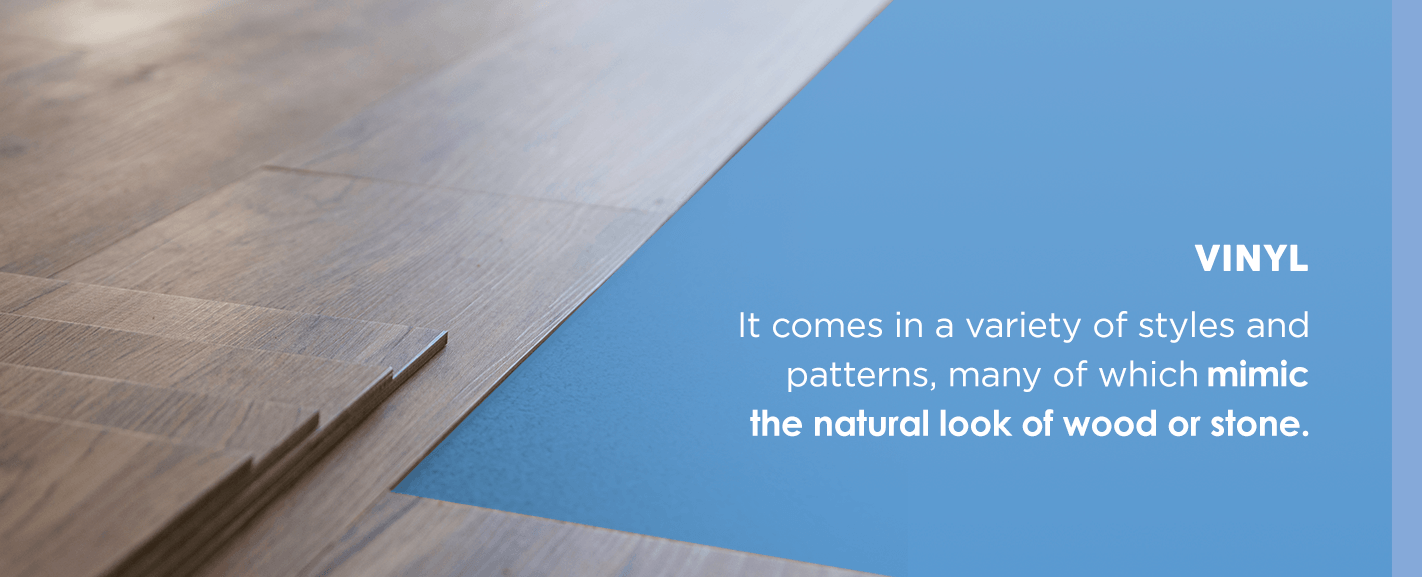

Luxury vinyl flooring is a man-made product typically sold in planks or tiles. This option has emerged as one of the top flooring choices for today’s homeowners, especially in nurseries. It comes in various styles and patterns, many of which mimic the natural look of wood or stone.
With its synthetic construction and multilayer design, luxury vinyl is durable enough to handle the wear and tear of your nursery. Four distinct layers — including a scuff- and scratch-resistant wear layer — provide the extra protection your nursery floor needs.
Several benefits of choosing luxury vinyl for your nursery include:
- Softness: Luxury vinyl is manufactured with either a felt or cork backing, which makes it more forgiving than natural hardwood. This makes it softer underfoot, and it also goes a long way toward absorbing sound.
- Longevity: When installed correctly and cared for properly, luxury vinyl can provide decades of reliable use. Its high durability and impressive construction make it especially practical for high-traffic areas like nurseries.
- Low-maintenance: This flooring won’t require re-staining or refinishing to keep its appearance. It’s also water-resistant, making it easy to wipe up spills and messes quickly. It doesn’t need special cleaners or products to keep it looking nice.
- Cost: Compared to materials like porcelain and ceramic, luxury vinyl is a much more affordable option. Ease of installation provides additional cost savings.
2. Laminate
Laminate flooring is a man-made composite that is designed to mimic the look of natural hardwood. Various design options are available to help you find the perfect aesthetic for your nursery while providing the functionality you need.
Today’s technologically advanced laminate floors feature several layers that create a high-performance solution for your most demanding flooring needs, including a wear layer that helps guard against everyday stains, scuffs and scratches.
More advantages of choosing laminate for your nursery flooring include:
- Durability: Laminate flooring has the look of hardwood, but it isn’t as delicate. A laminate floor will hold up to the wear and tear that comes with life in the nursery, and it won’t fade over time. In addition, laminate has built-in shields against humidity and moisture.
- Stain-resistance: Since laminate flooring is man-made, it doesn’t absorb liquids. Its non-absorption means it won’t stain, and it’s easy to clean up when messes happen. You don’t have to keep special cleaners on hand to mop up spills.
- Cost: Laminate is a more affordable alternative if you want the look of hardwood, but your budget just won’t allow it. Laminate also offers faster installation times, providing even more savings.
- Low maintenance: Caring for a laminate floor is as easy as sweeping, vacuuming or using a damp mop.
3. Hardwood
Who doesn’t love the classic look of hardwood floors? They never go out of style, which means the room won’t look dated as your child grows. If your nursery contends with more splashes, spills or minor accidents than usual, consider an engineered hardwood floor for increased moisture resistance and wear protection.
Although everyone is familiar with what hardwood floors look like, not everyone knows about this option’s many benefits, especially when it’s installed in a child’s room. Several advantages include:
- Beauty: Hardwood floors complement any décor, giving any room a clean, elegant look. Color and finish options range from walnut and maple to birch and oak.
- Durability: These floors hold up to whatever you — or your baby — can throw at them. Of course, over time, the finish may fade or become slightly scratched, but that’s nothing a little refinishing can’t correct.
- Easy to clean: Hardwood floors are easy to clean. When something gets spilled, you just need to quickly wipe it with a damp cloth and then dry the area. You can also sweep lightly with a broom to remove dust and ensure your nursery stays clean.
- Warmth: Hardwood floors retain heat reasonably well, which can help keep your baby comfortable during the winter months. Wood floors also look warm and inviting, especially when you add an area rug and some comfy furniture.
- Eco-friendly: Natural hardwood floors are more sustainable and healthier for your baby than synthetic materials. Solid hardwood doesn’t trap dust or emit chemicals, making it especially beneficial for babies with allergies.
4. Carpet
Carpeting is always a popular flooring option for a nursery. Why? It’s soft, it’s durable and it comes in a variety of shades to coordinate with any nursery décor. It’s a natural choice for a room where your baby might roll over, crawl and even climb out of the crib for the first time.
You can choose from various designs to achieve the look and function you want in your baby’s room, from plush and smooth Saxony to frieze and Berber.
Additional benefits of choosing carpeting for your nursery’s floor include:
- Budget-friendly: Carpeting is one of the most budget-friendly options for new flooring. Even a plush, durable carpet will cost less than other types of flooring, especially if the baby’s room isn’t very big.
- Baby-friendly: The best carpet for your nursery protects your baby from bumps and bruises. When you put wall-to-wall carpet in a nursery, you’ll find a warmer, softer flooring under your feet when you’re up for midnight feedings. Plus, as your baby grows and transitions into crawling and exploring, carpet provides a soft and safe space for them to move around.
- Noise-canceling: Carpet does a great job of canceling noise. It makes it easier to sneak in and check on your sleeping angel without waking them up. It also muffles sounds coming from other areas of the house, which is a huge benefit if there are other siblings or an enthusiastic pet around.
- Durability: Nylon, wool, cotton and other premium-grade materials provide various levels of durability and protection, letting you choose an option that best meets your nursery’s needs.
Tips for Choosing the Best Nursery Room Flooring


1. Consider Comfort
2. Make Clean-Up Easy
3. Think About Safety
4. Look at Samples
5. Get Recommendations
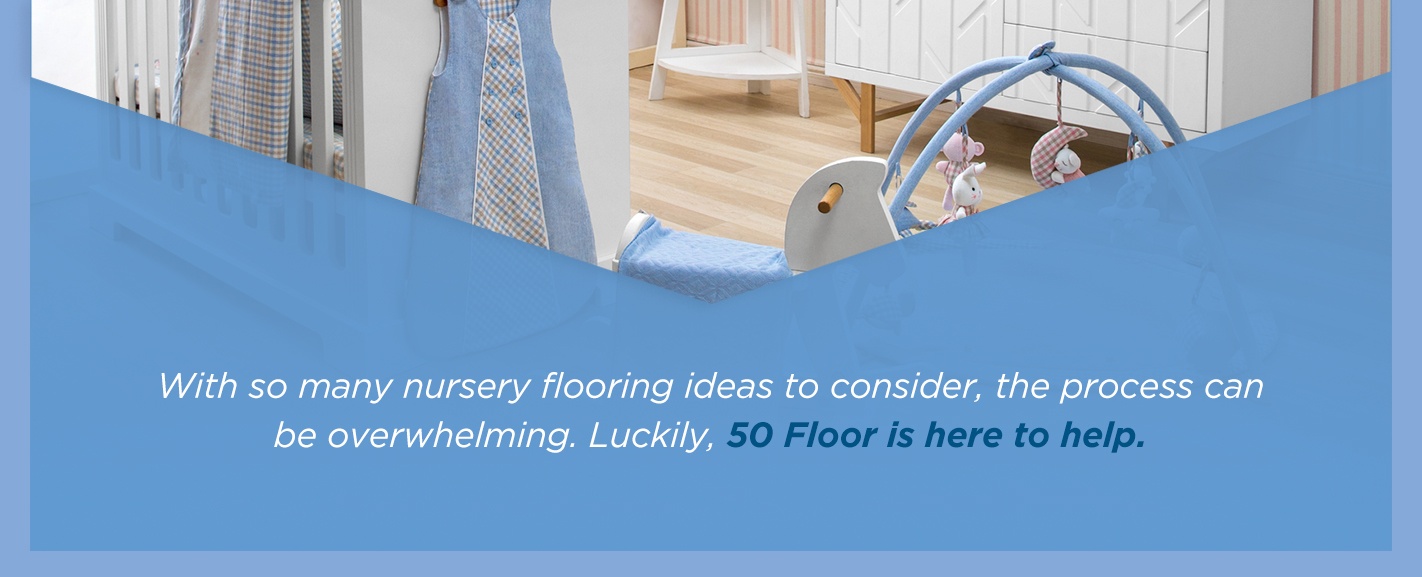

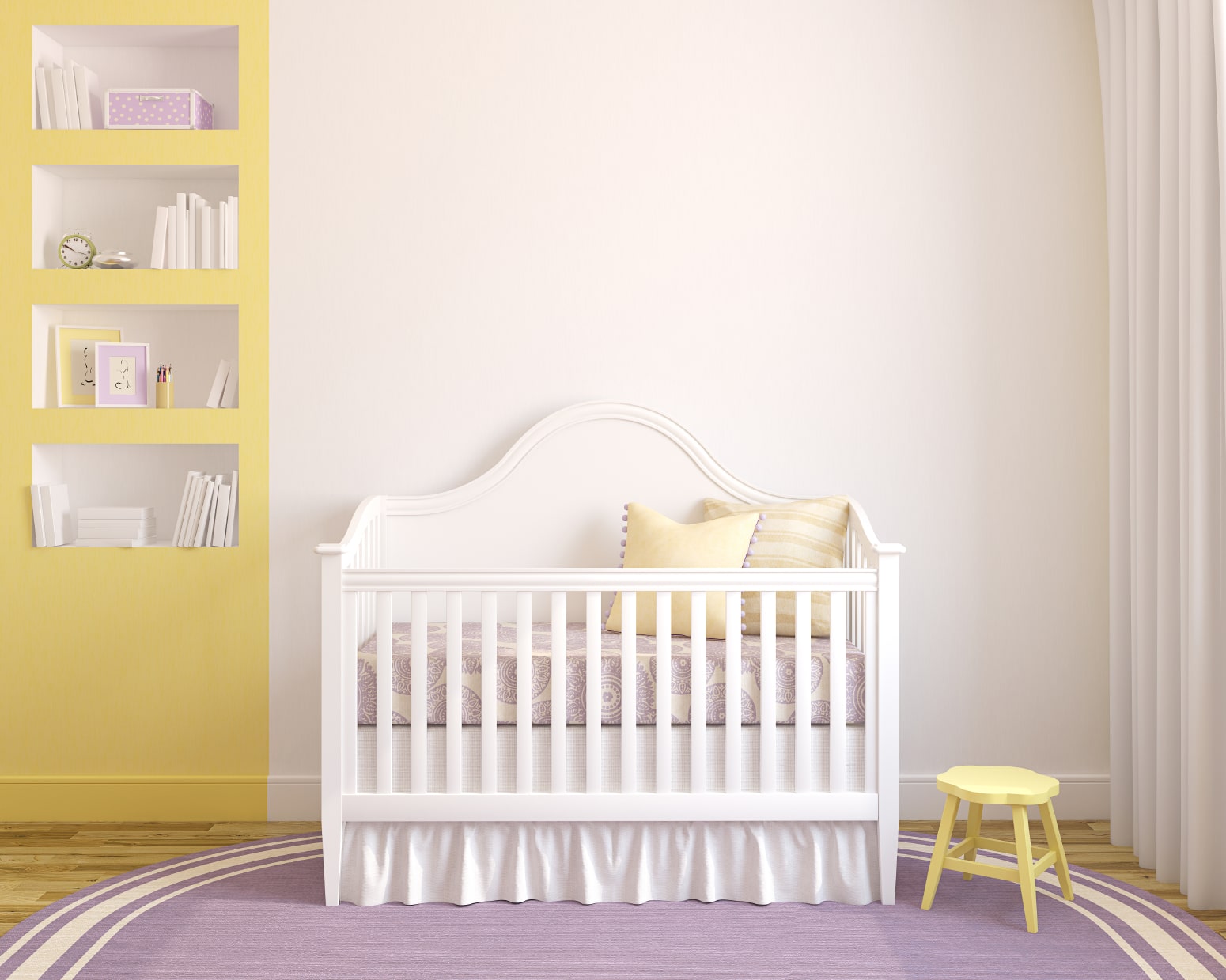

Find Nursery Flooring at 50Floor
With so many nursery flooring ideas to consider, the process can be overwhelming. Luckily, 50Floor is here to help.
At 50Floor, we know that choosing the right flooring for your baby’s nursery is essential to your baby’s health and comfort. We also know you have to stick to a budget. With both of those things in mind, our goal is to help you find the right flooring at the right price. What makes 50Floor different from other companies is that we bring the showroom to you.
When you schedule an appointment, we visit your home to show you samples and help you find a solution for the flooring in your nursery room. You get decades of flooring experience combined with the benefits of making decisions in the comfort of your own home.
Ready to choose high-quality flooring at affordable prices? Schedule an in-home flooring appointment today.

